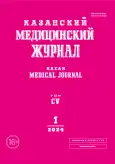Structural organization of the contralateral salivary glands
- Authors: Shchipskiy A.V.1, Mukhin P.N.1, Akinfiev D.M.2, Kalimatova M.M.1, Agalarova A.А.1
-
Affiliations:
- Moscow State Medical and Dental University named after A.I. Evdokimov
- National Medical Research Center for Obstetrics, Gynecology and Perinatology named after V.I. Kulakov
- Issue: Vol 105, No 1 (2024)
- Pages: 50-55
- Section: Theoretical and clinical medicine
- Submitted: 10.11.2023
- Accepted: 10.11.2023
- Published: 02.02.2024
- URL: https://kazanmedjournal.ru/kazanmedj/article/view/623187
- DOI: https://doi.org/10.17816/KMJ623187
- ID: 623187
Cite item
Abstract
BACKGROUND: It has been established that there are no functional differences between the paired salivary glands, but the presence or absence of structural differences in the contralateral salivary glands remains unknown.
AIM: To determine the presence of features of the contralateral salivary glands’ structural organization, which should be taken into account in the process of differential diagnosis in patients with various diseases of the salivary glands when analyzing sialograms.
MATERIAL AND METHODS: In 60 patients with diseases of the salivary glands, digital subtraction sialography of the parotid (right n=33, left n=26) and submandibular (right n=17, left n=19) glands was performed. The parameters of the paired glands were compared: the number and time of filling of the ducts with the water-soluble non-ionic contrast agent iodixanol. The sample was formed without taking into account gender, age and diseases. Cases with stones or ductal strictures were excluded. The significance of differences was assessed using Student's t-test. The results were considered significant at p ≤0.05.
RESULTS: The contrast time for the parotid glands (n=59) averaged 29.8±8.9 s: on the right — 31.0±8.0 s (n=33), on the left — 28.2±9.6 s (n= 26; t=1.2219); submandibular glands (n=36) — 28.6±11.6 s: on the right — 30.2±14.4 s (n=19), on the left — 27.3±8.3 s (n=17; t= 0.7284). The amount of drug injected into the ducts reflected their volume, which we considered as an accurate characteristic of their structural state. 1.4±0.3 ml of iodixanol (Visipack) was injected into the parotid glands (n=59): on the right — 1.4±0.3 ml (n=33), on the left — 1.4±0.3 ml (n =26; t=0). 1.2±0.3 ml was injected into the submandibular glands (n=35): on the right — 1.2±0.4 ml (n=17), on the left — 1.1±0.3 ml (n=18; t=0.8399). There was no significant difference between the contralateral glands, but there was a significant diffe¬rence between the parotid and submandibular glands (t=3.1247; p ≤0.001). When conducting scientific analysis, data from the contralateral salivary glands could be combined into a single sample. The amount of drug injected into the ducts served as a characteristic of the structural state of the gland.
CONCLUSION: The contralateral salivary glands do not have significant structural differences, and structural changes in the same patient are of the same type.
Full Text
About the authors
Alexander V. Shchipskiy
Moscow State Medical and Dental University named after A.I. Evdokimov
Author for correspondence.
Email: Sialocenter@mail.ru
M.D., D. Sci. (Med.), Prof., Depart. of Maxillofacial Surgery and Traumatology
Russian Federation, Moscow, RussiaPavel N. Mukhin
Moscow State Medical and Dental University named after A.I. Evdokimov
Email: panistom@mail.ru
ORCID iD: 0000-0002-8311-5529
M.D., Cand. Sci. (Med.), Assistant, Depart. of Maxillofacial Surgery and Traumatology
Russian Federation, Moscow, RussiaDmitriy M. Akinfiev
National Medical Research Center for Obstetrics, Gynecology and Perinatology named after V.I. Kulakov
Email: akinfiev_dmitrii@list.ru
ORCID iD: 0000-0003-4662-6757
M.D., Depart. of Radiation Diagnostics
Russian Federation, Moscow, RussiaMarina M. Kalimatova
Moscow State Medical and Dental University named after A.I. Evdokimov
Email: dockalimatova@mail.ru
ORCID iD: 0000-0002-0935-8936
PhD Stud., Depart. of Maxillofacial Surgery and Traumatology
Russian Federation, Moscow, RussiaAnara А. Agalarova
Moscow State Medical and Dental University named after A.I. Evdokimov
Email: anara.agalarova@yandex.ru
ORCID iD: 0009-0006-0679-0199
Lab. Assist., Depart. of Maxillofacial Surgery and Traumatology
Russian Federation, Moscow, RussiaReferences
- Shchipskiy AV, Kalimatova MM, Mukhin PN. Secretory function of the contralateral parotid glands. Kazan Medical Journal. 2022;103(6):1034–1039. (In Russ.) doi: 10.17816/KMJ112128.
- Pestova VN, Zaitseva EA. Saliva collection methods to account for salivation asymmetry in right-handed and left-handed people. Vyatskiy meditsinkiy vestnik. 2009;(1):115–116. (In Russ.)
- Kandyba DV. Stroke. Russian Family Doctor. 2016;20(3):5–15. (In Russ.) doi: 10.17816/RFD201635-15.
- Bondarenko IA, Chesnakova TV. Situs viscerus inversus totalis (clinical case). Radiology — practice. 2014;(2):57–63. (In Russ.)
- Kasimova RM, Timoshok AD. Situs viscerus inversus totalis (clinical case). Scientific review. Pedagogical sciences. 2019;(5-3):69–74. (In Russ.)
- Tsimmernam YaS, Dimov AS. Scientific legacy of I.V. Davydovsky — philosophical foundations of general pathology. Clinical Medicine. 2016;(8):565–574. (In Russ.) doi: 10.18821/0023-2149-2016-94-8-565-574.
- Romacheva IF, Yudin LA, Afanasyev VV, Morozov AN. Zabolevaniya i povrezhdeniya slyunnykh zhelyoz. (Diseases and injuries of the salivary glands.) M.: Meditsina; 1987. 238 р. (In Russ.)
- Afanasyev VV, Mirzakulova UR. Slyunnye zhelezy. Bolezni i travmy. Rukovodstvo dlya vrachey. (Salivary glands. Diseases and injuries. A guide for doctors.) M.: GEOTAR-Media; 2019. 315 р. (In Russ.)
- Höhmann D, Landwehr P. Clinical value of sialography in digital and conventional imaging technique. HNO. 1991;39(1):13–17. (In Germ.) PMID: 2030081.
- Tshipskiy AV, Kondrashin SA. Contrast radiography of the salivary glands. Stomatologiya. 2015;94(6):45–49. (In Russ.) doi: 10.17116/stomat201594645-49.
- Borkovic Z, Peric B, Ozegovic I. The value of digital subtraction sialography in the diagnosis of diseases of the salivary glands Acta Stomat Croat. 2002;36(4):505–506.
Supplementary files








